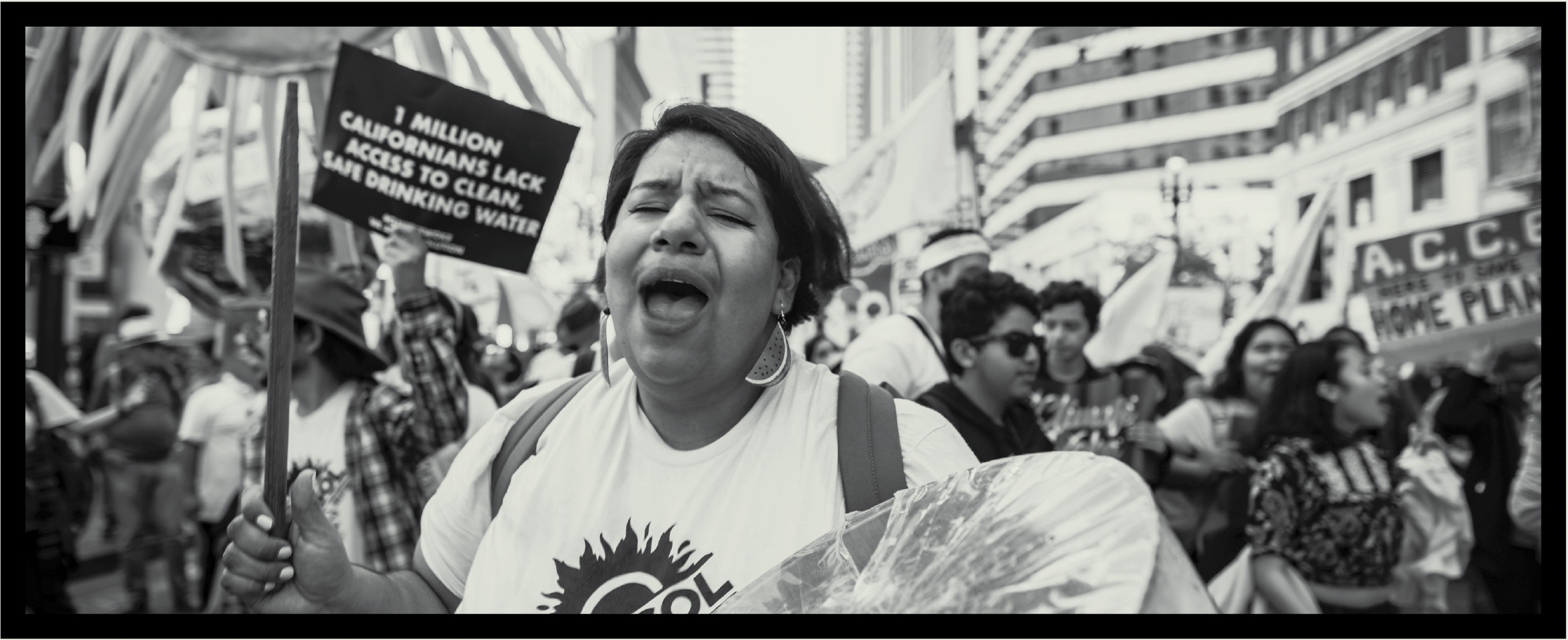
photo via the Climate Justice Alliance (Flickr)
Shortly after BEF was announced, BEF consultants reached out to a small number of grassroots leaders and asked for consultation around who and what to fund in the field. These leaders, in turn, moved a collective strategy and negotiation to ensure Black, Indigenous, and People of Color–led organizations on the frontlines of labor and CJ issues would be resourced as part of the early set of awardees. Bezos and his team repeatedly expressed an interest in learning from these grassroots leaders as BEF staff and leadership were new to the field of philanthropy and funding around climate change.
HOW DID GRASSROOTS LEADERS ADVISE BEZOS AND TEAM TO FUND THE FRONTLINES?
- Invest directly in the grassroots, particularly in BIPOC communities that have been most impacted by environmental racism and climate injustice.
- Fund bottom-up organizing strategies and intersectional solutions rooted in local communities that address structural issues.
- Engage the People’s Solutions Lens to mitigate against the instinct to fund non-systemic solutions that perpetuate practices of exploitation and extraction.
- Fund that provide flexible core support and include grassroots leadership in decision-making bodies and other methods for accountability.
- Fund “at scale,” given the current data that demonstrates only 3% of climate philanthropic giving in the United States is going to frontline communities. This is an opportunity to redistribute this wealth to the communities that built it.
In addition to quiet, behind-the-scenes meetings, interventions and co-organizing by grassroots leaders with the Bezos team, the ecosystem activated a number of additional strategies:
- reaching out across their networks to promote hiring opportunities at BEF,
- writing articles and statements on the problematic practices of billionaire philanthropy, and
- strategizing a movement response to different possible scenarios in order to be ready in advance of the first round of grants.
This organizing led to a movement proposal for an amount comparable to what big greens had already received – a minimum $100 million docket of funding by BEF – across multiple labor and CJ organizations. Still, this would have represented a modest level of investment into grassroots organizations in comparison to the big greens. Ultimately, BEF only agreed to fund intermediaries, though grassroots leaders and movement-accountable intermediaries had advocated for funding both intermediaries and grassroots EJ and CJ partners directly.
This organizing resulted in $141 million being moved into frontline groups through intermediaries funding the grassroots, representing a doubling of U.S. climate philanthropy for equity via intermediary funds. But even this initial scale of resources paled in comparison to the big greens and other intermediaries who made up the bulk of the first round of grants, which totaled approximately $750 million. Multiple grassroots organizations, via grassroots-accountable intermediaries, received $141 million spread among them. In contrast, the big green organizations received $100 million grants each, almost as much as grassroots groups received in total.
BIG GREENS:
- ClimateWorks Foundation, $50 million
- Dream Corps Green For All, $10 million
- Eden Reforestation Projects, $5 million
- Energy Foundation, $30 million
- Environmental Defense Fund, $100 million
- Natural Resources Defense Council, $100 million
- The Nature Conservancy, $100 million
- Rocky Mountain Institute, $10 million
- Salk Institute for Biological Studies, $30 million
- Union of Concerned Scientists, $15 million
- World Resources Institute, $100 million
- World Wildlife Fund, $100 million
GRASSROOTS (to be regranted among a pool of 500 grassroots grantees)
- NDN Collective, $12 million
- The Climate and Clean Energy Equity Fund, $43 million
- The Hive Fund for Climate & Gender Justice, $43 million
- The Solutions Project, $43 million
While the outcomes are mixed, there are many elements worth celebrating:
- Grassroots leaders came together quickly to create a collective strategy, with a large number of people working in collaboration to achieve a complex set of goals.
- Leaders aligned around a common higher purpose due to the high stakes, a significant achievement when this level of cooperation is sometimes challenging for our movements to achieve.
- The ecosystem, from leaders to staff to communities, showed up. Everyone had a role, and multiple players moved with pragmatic grace.
- Leaders were inspired by, rooted in and accountable to the labor movement and Amazon workers, which became a foundational point of alignment for the ecosystem. Respecting the wishes of workers and seeking consultation from them to inform the strategy was critical.
- Frontline labor leaders gave frontline climate leaders their support to move forward and take the money if it was offered to them at a meaningful scale, and grassroots leaders agreed to include support for the demands of workers.
This alignment and willingness to contest for the resources of a billionaire like Bezos was testament to several years of learning and organizing around complex concepts. Namely, if movement organizations were going to contest for “dirty money,” it needed to be used to mitigate the harm done to workers and the many structural harms of wealth and resource extraction at the expense of frontline communities.
Ultimately, this harm reduction strategy achieved a level of success in moving a portion of overall resources, but it was unsuccessful in influencing the Bezos team to fund grassroots groups directly in the first round of grants, and BEF did not adopt the basic practices of trust-based philanthropy. Therefore, grassroots leaders began to organize a resource-sharing intervention with some of the big green BEF grantees, which was a strategy to redirect resources to fund frontline groups.
To download the PDF of “Good, Bad, Bezos And Beyond: Climate Philanthropy And The Grassroots” report, click here.
